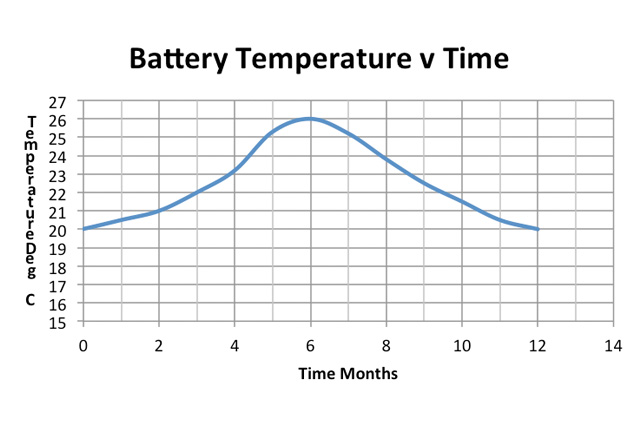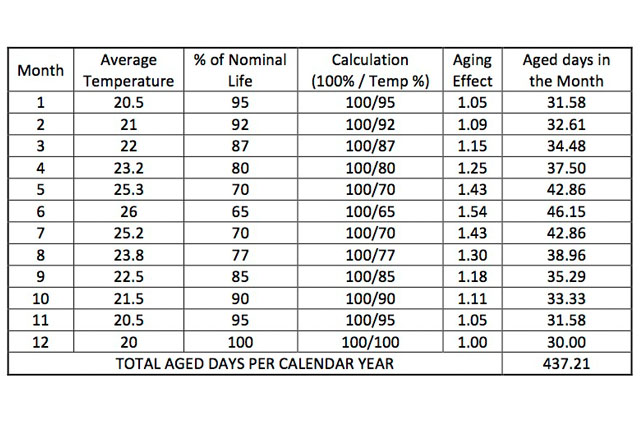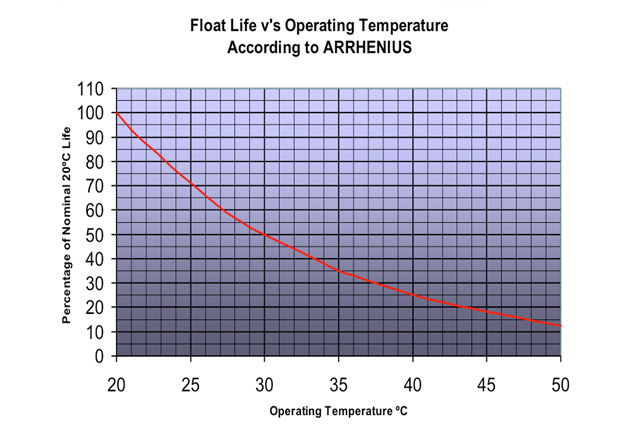How Does Temperature Affect Lead Acid Batteries?
It is well known that all lead-acid batteries will have a shorter life when operated at a higher temperature. This is the case no matter what type lead-acid battery it is and no matter who manufacturers them. The effect can be described as the ARRHENIUS EQUATION.
Svante Arrhenius, was a Swedish scientist who discovered the life of lead-acid batteries is affected by variations in temperature. He established that for every 10ºC increase in temperature the battery life would be halved. Therefore, as an example, it follows that if the life is 30 years at 15ºC then at 25ºC the life will be 15 years. The equation also suggests that at 5ºC the life will be 60 years but unfortunately other things come into play when batteries are very old, typically over 30 years, and the Arrhenius equation is only really valid between about 15ºC and 40ºC for operational batteries.
Why is the life reduced? There are many interacting electro-chemical effects but one of the main reasons is that for any given constant voltage that is applied to the battery by the float charger there will be a resultant float current. Lead-acid batteries will accept more current if the temperature is increased and if we accept that the normal end of life is due to corrosion of the grids then the life will be halved if the temperature increases by 10ºC because the current is double for every 10ºC increase in temperature. It has also been shown that evaporation of water through the container walls occurs and if the temperature is increased then evaporation will also increase. This may result in drying out of some batteries of the VRLA AGM and VRLA GEL type. However, this is a complex subject that cannot be easily calculated and applied to give a predicted life. In any case, good quality lead-acid batteries will not normally fail due to drying out. Drying out is not relevant to vented types and we can use the Arrhenius equation to give an estimate of the life when the operational temperature is different to the design temperature.
In Europe it is common for battery lives to be quoted when operating at a continuous temperature of 20ºC. If the temperature is 10ºC for 3 months, this will not reduce the overall life by half but only a percentage of the expected 20ºC life. However, operating at 21ºC and not at 20ºC for the entire life will reduce the life by almost 10%.
We also have to be careful when we refer to life and separate “design life” and “real life”.
A VRLA AGM battery may be quoted as having a design life of 10 years but the real life, even when operated continuously at 20ºC, will be nearer 8 years. Similarly, some have quoted high performance planté batteries as having a design life of 25 years, but there are many examples of this type of battery sill in service after over 30 years. What we do know is that operating at a higher temperature will reduce the life of lead-acid batteries.
We should also consider the battery configuration and thermal management. If, for example, the battery is arranged on a 6 tier stand that could easily be over 2m high, it is not uncommon for there to be a 5ºC difference between the bottom and top of the battery. If the cells or monoblocs are all in the same string the aging will be more or less the same for those on the bottom tier as those on the top tier. This is because the float current will be the same throughout that battery. However, because only part of the battery is at a higher temperature, the float current will not follow the Arrhenius equation. Never the less, a reduction in life will result.
Thermal management is particularly important when the battery is in an enclosure. Ideally, the use of runners is preferred to shelves and if shelves are used they should be perforated to allow a vertical movement of air. The cells or monoblocs should be spaced to provide a minimum of 10mm gap between the units on all four sides. Slots or holes within an enclosure should be provided to give a sweeping action of the circulating air from the base of the enclosure over the battery and exiting at the top on the opposite side to the inlet point. This will also assist in the removal of explosive hydrogen gas which is produced. Where air conditioning is used within a battery room, sufficient air flow must be catered for to prevent a temperature gradient between the top of the battery and bottom. Under all circumstances and for all installations, there should be no more than a 2ºC difference in temperature of the units between the top and bottom of the battery.
If the battery is subjected to particularly high temperature or if thermal management is poor, the battery may go into thermal runaway. If this occurs, the complete battery will be destroyed. Thermal runaway can occur within a very short time and cases have been reported after only a few weeks of installing a new battery system.
The use of temperature compensated charging equipment is recommended to minimise the risk of thermal runaway. A reduction of the float voltage will to some extent mitigate the loss of live but it will not remove the effects completely. Users should consult the battery supplier for detailed information.
The graph below may be used to estimate the life when operated on float systems at different operating temperatures. The graph may be used to estimate the effect of different daily or monthly operating temperatures. EG, one day at 30ºC will have the effect of 2 days at 20ºC.
An example to estimate the life at different temperatures follows.
Example:
A battery has a design life of 12 years in accordance with IEC 60896 and the typical operating temperature is as the chart below: Note: 12 years = 4380 days.

The above can be rationalised to an approximate monthly average as follows: -
From the chart below we can see that for every year the battery has aged 437 days and not 365 days.
Therefore the battery will last 4380 / 437 = 10years and not 12 years.


We hope this latest blog post has proven useful in further understanding the affect of temperature on lead acid batteries. The team at Blue Box Batteries has extensive experience in this field are always available to make sure you are provided the best possible information available to ensure optimum service life from your battery system.
Latest Headlines
Bulk Orders
Discounted prices are available for bulk orders, please contact us to discuss your requirement.